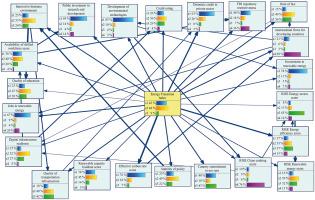Exploring interconnected indicators of energy transition: A global perspective
IF 3.6
引用次数: 0
Abstract
This study aims to evaluate the relative importance of the pillars and indicators within the Energy Transition Index (ETI) and their influence on overall ETI performance. Using a dataset from the World Economic Forum's 2024 ETI report, which covers 120 countries, this research applies Bayesian Belief Networks (BBNs), a probabilistic graphical modeling technique suited for analyzing complex interdependencies among variables. Two models are developed: one connecting the ETI to its eight pillars, and another linking it to 22 selected indicators. Findings reveal that the finance and investment pillar has the strongest positive association with ETI scores, whereas innovation is the area with the highest concentration of low-performing countries. Additionally, strong synergies are observed across digital infrastructure readiness and education quality, highlighting opportunities for multi-dimensional policy interventions. The study provides actionable insights for policymakers, such as prioritizing financial instruments, strengthening regulatory frameworks, and enhancing educational and digital infrastructure to accelerate progress in energy transitions.

探索能源转型的相互关联指标:全球视角
本研究旨在评估能源转型指数(ETI)中支柱和指标的相对重要性及其对整体ETI绩效的影响。本研究使用了世界经济论坛2024年ETI报告中的数据集,该报告涵盖了120个国家,该研究应用了贝叶斯信念网络(bbn),这是一种适合分析变量之间复杂相互依赖关系的概率图形建模技术。开发了两个模型:一个将ETI与其八个支柱联系起来,另一个将其与22个选定指标联系起来。研究结果显示,金融和投资支柱与ETI得分的正相关最强,而创新是低绩效国家最集中的领域。此外,在数字基础设施就绪度和教育质量方面观察到强大的协同效应,突出了多维政策干预的机会。该研究为政策制定者提供了可操作的见解,例如优先考虑金融工具,加强监管框架,加强教育和数字基础设施,以加速能源转型的进展。
本文章由计算机程序翻译,如有差异,请以英文原文为准。
求助全文
约1分钟内获得全文
求助全文

 求助内容:
求助内容: 应助结果提醒方式:
应助结果提醒方式:


